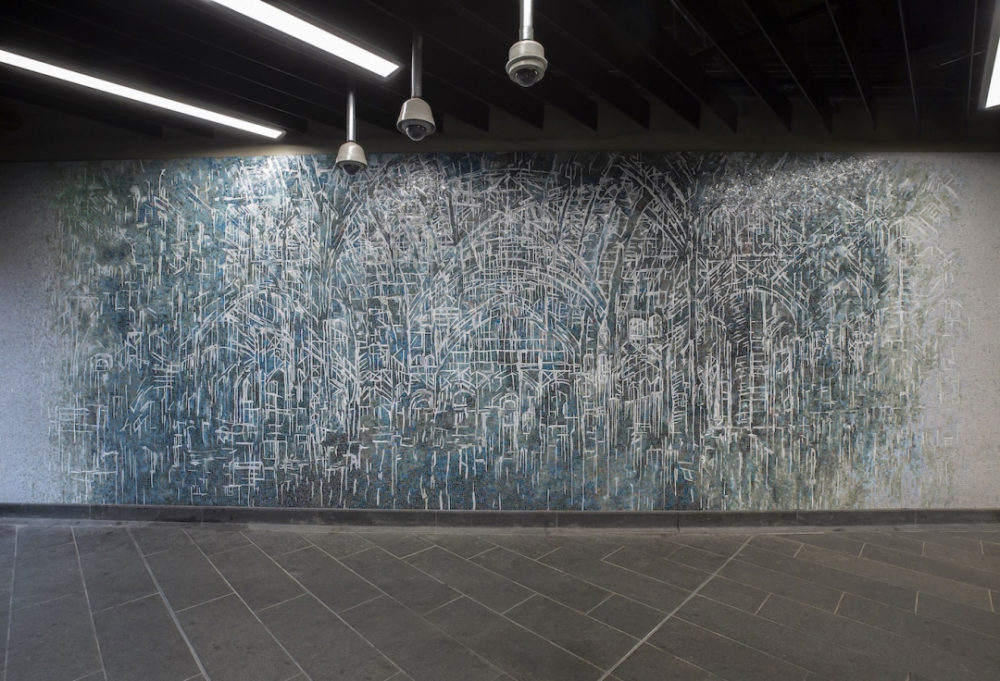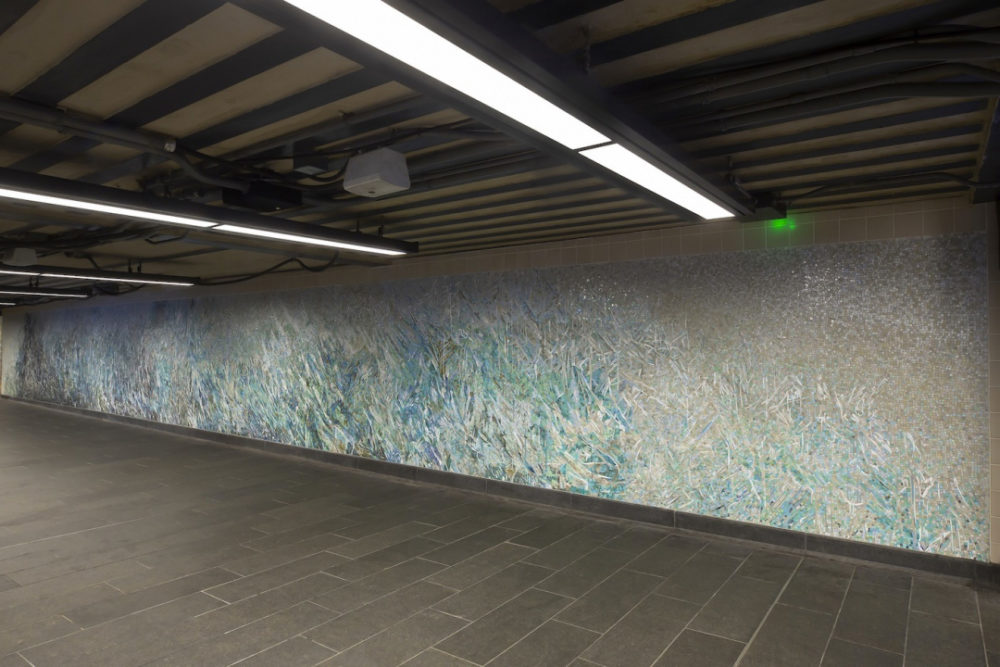
- Source: HYPERALLERGIC
- Author: ZACHARY SMALL
- Date: MAY 01, 2019
- Format: DIGITAL
The Arches of Old Penn Station Return in Diana Al-Hadid’s Subway Mosaics
The permanent installations line the mezzanines at the 34th Street Penn Station stop with fluid line work and ghostly presence.

Diana Al-Hadid, “The Arches of Old Penn Station” (2018) (© Diana Al-Hadid, NYCT 34th Street-Penn Station, commissioned by Metropolitan Transportation Authority Arts & Design, photo by Peter Kaiser)
Everybody misses the grandiose interiors of the old Penn Station — even if you (like me) weren’t alive to see it in person. But the ghostly shadows of that long-demolished pride of New York City are preserved in the mosaics of artist Diana Al-Hadid.
Commissioned by MTA Arts & Design for the mezzanine spaces at the 34th Street Penn Station subway stop, the permanent installation consists of two long murals. “The Arches of Old Penn Station” is an impressionist work of fluid line and turquoise tiling that recalls the latter-day bravura of the 1910 building, which was designed by the architecture firm McKim, Mead, and White. “The Arc of Gradiva” is based upon the literary work of the German author Wilhelm Jensen.

As New York prepares to demolish the current Penn Station — one of the world’s most-despised transit hubs — the artist’s murals will remind straphangers of a bygone America that once engineered its infrastructure for ease, aesthetics, and scale. It’s a far cry from our current subterranean rat’s maze constructed in the 1960s. The $1.6 billion budget for a new station was finalized in 2017, but construction plans have stalled as financing commitments for the larger $30 billion-plus Gateway Project have floundered. Developers have long-predicted that construction would start in 2020, and that might happen if the $2 trillion infrastructure deal spearheaded by President Donald Trump, House Speaker Nancy Pelosi (D-CA), and Senate Minority Leader Chuck Schumer (D-NY) can pass the Republican-held Senate.
There is an anticipation of change in Al-Hadid’s murals, particularly for the one depicting the old Penn Station. The image of the bygone transit hub emerges form a hazy cloud of grey tiles like a memory fading back into view. It is a palimpsest upon the wall, a reminder of former glory and a bequest for a better future. The artist has created etch-like markings on the mosaic with thinly sliced white tiles, that reinvent the famous image of the station’s concourse as a blueprint with perspectival depth and a hint of abstraction.

Diana Al-Hadid, “The Arc of Gradiva” (2018) (© Diana Al-Hadid, NYCT 34th Street-Penn Station, commissioned by Metropolitan Transportation Authority Arts & Design, photo by Peter Kaiser)
More cryptic is the artist’s “Gradiva” mosaic, which takes its titular subject from an early-20th-century novel of the same name by the German author Wilhelm Jensen. The book is itself a reference to a Roman bas-relief of the same name, which was popular with intellectuals at the turn of the century. Sigmund Freud even kept a copy of the sculpture in his study, and later analyzed Jensen’s novel in his 1907 essay, “Delusion and Dream in Jensen’s Gradiva.” The novel is a surreal story about an archaeologist fantasizing about the mythological female figure, later meeting the woman in what could be either reality or a dream. Freud took the story as an anxious expression of the subconscious pointing toward the main character’s Oedipal complex.
All these details make for a surprisingly dense historical background for a public artwork plunked into the subway system, but it’s not exactly a surprise for those who know Al-Hadid’s oeuvre. Over the last few years, Gradiva has become a reoccurring reference in the artist’s work, which often plays with concepts of perspective, time, and space. The Roman figure was last seen as a fiberglass and steel sculpture at Al-Hadid’s 2018 exhibition inside Madison Square Park. Here and there, Gradiva is a symbol of undefined longing, a woman trapped between the annals of time, the real and the imagined. In her subway mosaic, Al-Hadid portrays the woman as a sweeping silhouette, a ghostly penumbra that leaves a bluish cloud of smoke behind here in what appears to be a petrified forest of white trees.
Reviewed as a diptych, each mural clarifies the other’s intention. The arches of old Penn Station reference our will to recreate history; by contrast, Gradiva is an expression of our collective longing for the past, which remains as elusive and ill-defined as ever. What shape will the new Penn Station take when it comes, if it comes? And will we love it as much as the old station, which the majority of us have never personally experienced? The results are unclear, but Al-Hadid’s new mosaics keep the dream alive.

Diana Al-Hadid, “The Arc of Gradiva” (2018) (© Diana Al-Hadid, NYCT 34th Street-Penn Station, commissioned by Metropolitan Transportation Authority Arts & Design, photo by Peter Kaiser)

